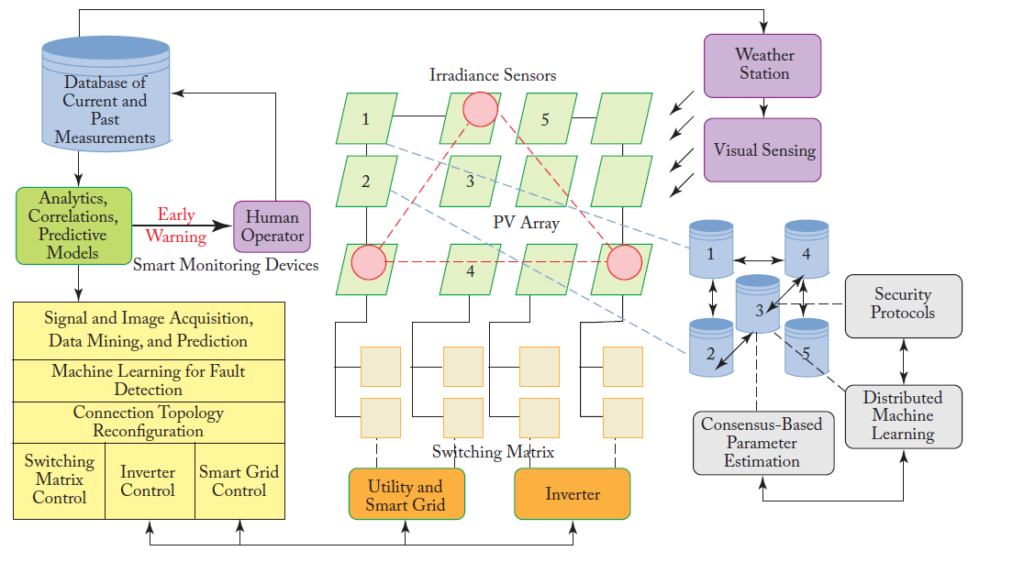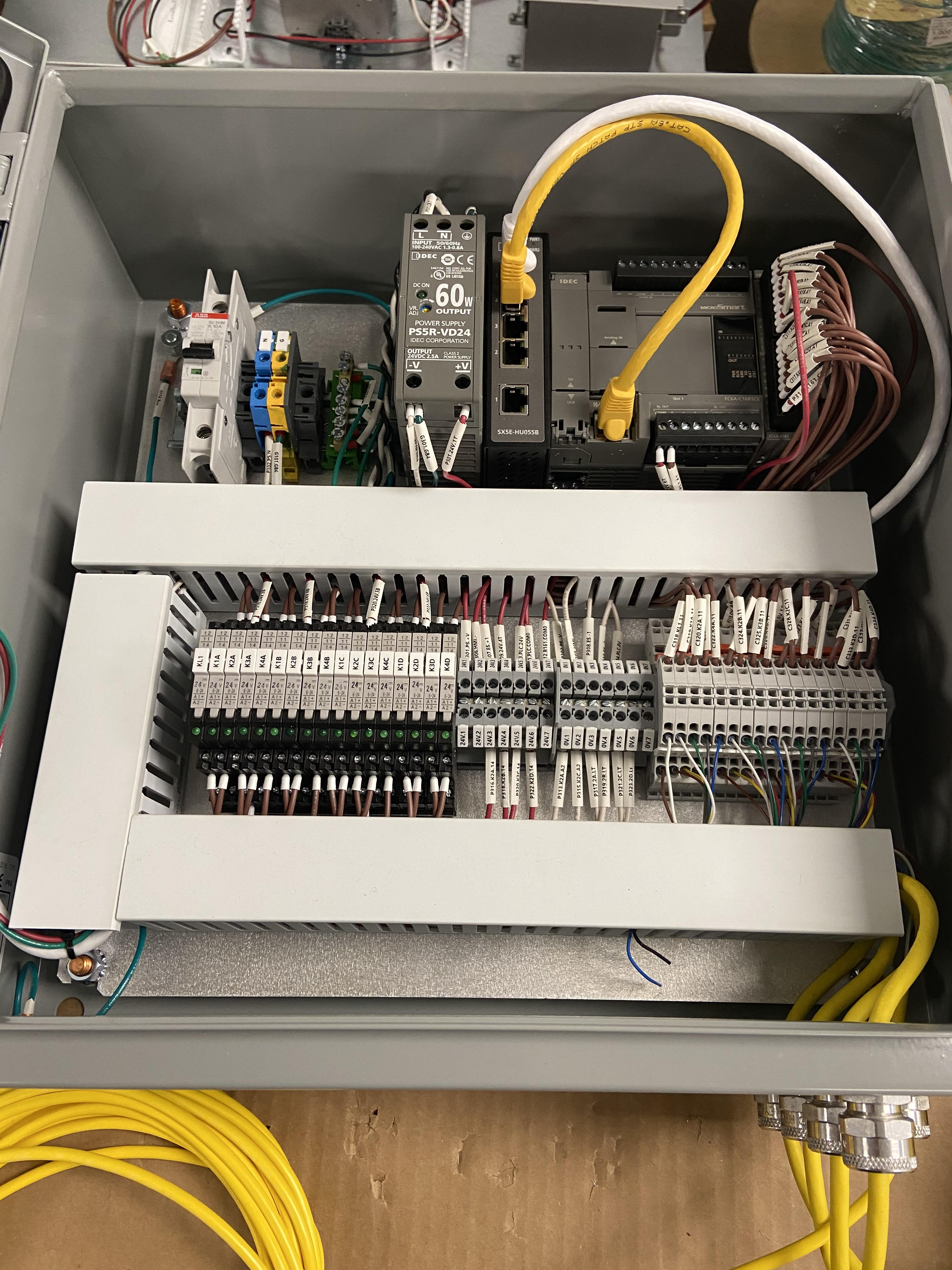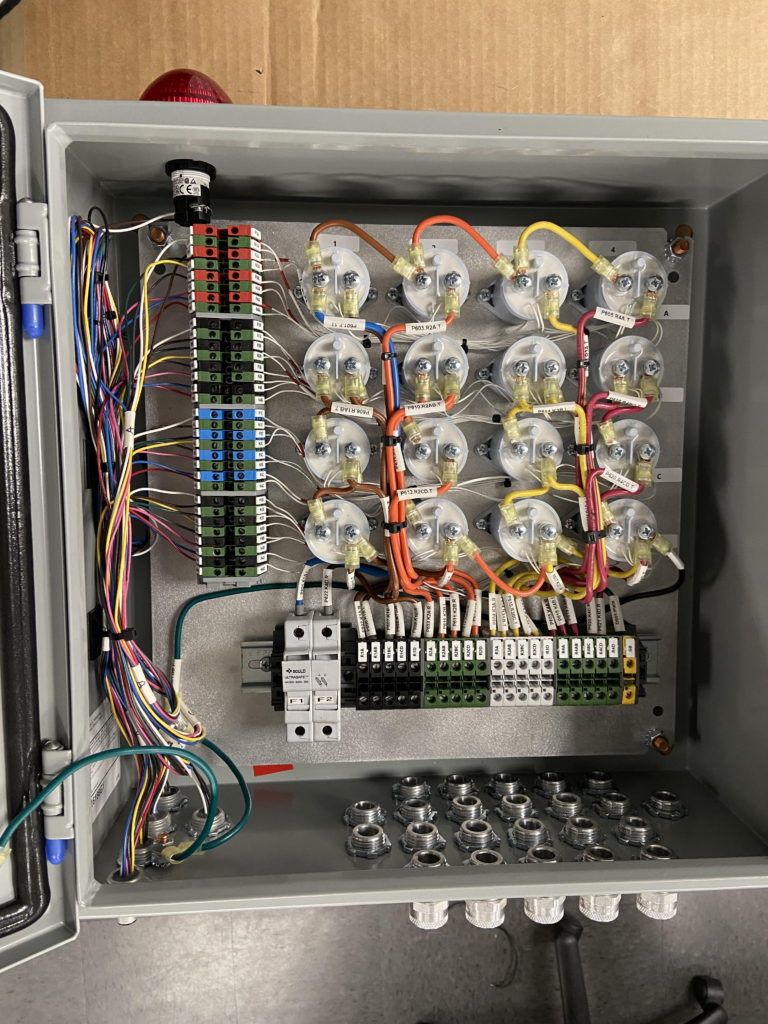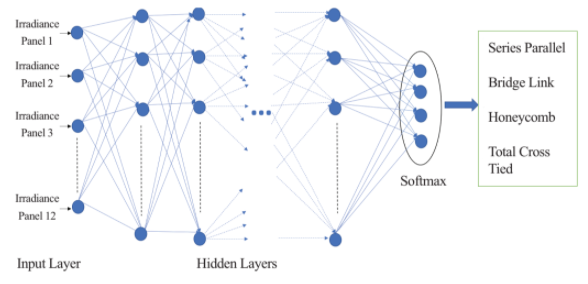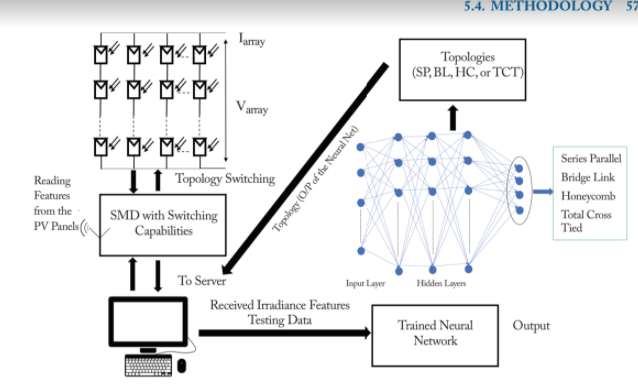Fault Classification in Photovoltaic Arrays Using Graph Signal Processing- ICPS 2020 |
Abstract: In this paper, we address the problem of fault classification in PhotoVoltaic (PV) arrays using a semisupervised graph signal processing approach. Traditional fault detection and classification methods require large amounts of labeled data for training. In utility-scale solar arrays, obtaining labeled data for different fault classes is resource-intensive. We propose a graph-based classification technique that relies on a limited amount of labeled data. We compare our results with the well known supervised machine learning classifiers such as the K-nearest neighbor classifier, random forest classifier, support vector machines, and artificial neural networks. We also show that the graph-based classifiers require lower training computational cost compared to the standard supervised machine learning algorithms. The proposed method also achieves good classification performance with unseen data. We validate our method on a real-time dataset and show significant improvements over existing approaches.
Figure 1: An illustrative block diagram of a graph-based semi-supervised fault classification and diagnosis.
Introduction:
In this work, we develop a graph signal processing based semi-supervised learning technique, which achieves good performance in fault classification with relatively limited data. More specifically, we adopt a semi-supervised graph-based classifier to identify commonly occurring PV faults. We view the solar PV array as a connected graph, similar to Figure 1, and associate graph signals to represent the measurements of the PV modules. First, a classifier is trained on the data available from the labeled nodes. The constructed graph is then used to propagate information from labeled samples to the unlabeled samples. Since graph-based methods are semi-supervised, the method requires lower computational cost than conventional supervised machine learning (ML) classifiers and ANNs.
A graph G = (V,A) has N nodes and described by an N ×N matrix A which characterizes the relationships among all nodes. The graph signal is defined as s and, based on the relationship among the nodes, GSP operators can be designed to conduct (propagate) the graph signal s, throughout the graph. Consider a graph shift matrix A, then the graph shift operation is given by s = As. In graph domain, an Lth order shift-invariant graph filter is defined as H = h(A) = h0I + h1A1 + ···hLAL, where hi are scalar coefficients of the graph filter H. Then we can conduct the graph filter operator H on the graph signal s as, sfil = Hs, where, sfil denotes the filtered graph signal. In this paper, the fault classification is achieved through a graph filtering process. We use an N ×D matrix X to represent the initial dataset. Similarity among the nodes on the graph is represented by the graph shift matrix. The problem of fault classification translates to the node classification problem on the graph, wherein, each node belongs to a particular class. Given feature matrix X, graph shift matrix A, and the node target class matrix S, our goal is to find the graph filter H, which classifies the nodes into true classes. The filter taps hl of the filter H is computed by solving the convex objective function.
We examine the test accuracy and error rates of all classifiers under different labeling ratios α from 0.2 to 0.7. The results are reported in Table I. We find that, in all cases of α, the GSP method significantly outperforms the other methods. GSP had the best error rate performance among all classifiers with a 9.32% error followed by ANNS with 9.61%. The superior performance of the GSP method can be attributed to the structural graph data along with the measurement data to construct the classifier.
References:
[1] Y.Zhao, et.al, “Graph-based semi-supervised learning for fault detection and classification in solar photovoltaic arrays,” IEEE Trans. on Power Elec., vol. 30, pp. 2848–2858, 2014.
[2] Muniraju, S. Rao, S. Katoch, A. Spanias, C. Tepedelenlioglu, P. Turaga, M. K. Banavar, and D. Srinivasan, “A cyber-physical photovoltaic array monitoring and control system,” International Journal of Monitoring and Surveillance Tech. Research (IJMSTR), vol. 5, no. 3, pp. 33–56, 2017.
[3] Zhao, B. Lehman, R. Ball, J. Mosesian, and J.-F. de Palma, “Outlier detection rules for fault detection in solar photovoltaic arrays,” in 2013 Twenty- Eighth Annual IEEE Applied Power Electronics Conference and Exposition (APEC). IEEE, pp. 2913–2920, 2013.
[4] Rao, A. Spanias, and C. Tepedelenlioglu, “Solar array fault detection using neural networks,” in 2019 IEEE International Conference on Industrial Cyber-Physical Systems (ICPS). IEEE, pp. 196–200, 2019.
[5] Katoch, G. Muniraju, S. Rao, A. Spanias, P. Turaga, C. Tepedelenlioglu, M. Banavar, and D. Srinivasan, “Shading prediction, fault detection, and consensus estimation for solar array control,” in 2018 IEEE Industrial Cyber-Physical Systems (ICPS). IEEE, pp. 217–222, 2018.
[6] Sandryhaila and J. M. Moura, “Discrete signal processing on graphs,” IEEE transactions on sig.l processing, vol. 61, no. 7, pp. 1644–1656, 2013.
[7] Sandryhaila and J. Moura, “Discrete signal processing on graphs: Graph filters,” in 2013 IEEE International Conference on Acoustics, Speech and Signal Processing. IEEE, pp. 6163– 6166, 2013.
[8] Chen, A. Sandryhaila, J. M. Moura, and J. Kovaceviˇ c, “Adaptive graph filtering: Multiresolution classification on graphs,” in 2013 IEEE Global Conference on Sig. and Information Processing. IEEE, pp. 427–430, 2013.
Machine Learning for Solar Array Monitoring, Optimization, and Control- Morgan and Claypool 2020 |
Abstract: The efficiency of solar energy farms requires detailed analytics and information on each panel regarding voltage, current, temperature, and irradiance. Monitoring utility-scale solar arrays were shown to minimize the cost of maintenance and help optimize the performance of the photovoltaic arrays under various conditions. We describe a project that includes the development of machine learning and signal processing algorithms along with a solar array testbed for the purpose of PV monitoring and control. The 18kW PV array testbed consists of 104 panels fitted with smart monitoring devices. Each of these devices embeds sensors, wireless transceivers, and relays that enable continuous monitoring, fault detection, and real-time connection topology changes. The facility enables networked data exchanges via the use of wireless data sharing with servers, fusion and control centers, and mobile devices. We develop machine learning and neural network algorithms for fault classification. In addition, we use weather camera data for cloud movement prediction using kernel regression techniques which serves as the input that guides topology reconfiguration. Camera and satellite sensing of skyline features as well as parameter sensing at each panel provide information for fault detection and power output optimization using topology reconfiguration achieved using programmable actuators (relays) in the SMDs. More specifically, a custom neural network algorithm guides the selection among four standardized topologies. Accuracy in fault detection is demonstrated at the level of 90C% and topology optimization provides an increase in power by as much as 16% under shading.
Figure 2: Overview of our research vision in Solar Panel Monitoring. Our system integrates shading prediction using irradiance and satellite imaging data, topology reconfiguration by controlling the switching matrix, and fault classification and diagnosis modules.
Load Design:
We are currently working on a load for real-time monitoring of PV arrays. This resistive load will enable MPPT tracking. The design includes the use of switches and relays to allow for MPPT tracking throughout the day. The resistors are automatically turned off/on based on the load requirement. We will validate our machine learning algorithms based on the data received from the array.
Figure 3: A look into the electrical connectivity of the load which can perform MPPT tracking.
Patents and papers:
- Fan, S. Rao, G. Muniraju, C. Tepedelenlioglu, and A. Spanias, Fault classification in photovoltaic arrays using graph signal processing, US patent application number 63/039,012, Provisional Patent submitted Skysong Innovations, 2020.
- Rao, A. Spanias, and C. Tepedelenlioglu, Machine learning and neural nets for solar array fault detection, Patent Pre-disclosure, provisional US patent application number 62/843,821, Utility Patent application submitted, Skysong Innovations), 2020.
- Fan, S. Rao, G. Muniraju, C. Tepedelenlioglu, and A. Spanias, Fault classification in photovoltaic arrays using graph signal processing, ICPS, Tampere, June 2020.
- Sunil Rao, Sameeksha Katoch, Vivek Narayanaswamy, Gowtham Muniraju, Cihan Tepedelenlioglu, Andreas Spanias, Pavan Turaga, Raja Ayyanar, and Devarajan Srinivasan, Machine Learning for Solar Array Monitoring, Optimization, and Control, Morgan and Claypool, 2020.
Reconfiguring Photovoltaic Arrays for Maximum Power Output Extraction using Neural Networks |
Abstract:
The production of PV energy is affected by external conditions such as partial shading, varying temperatures, and soiling of PV panels. Among these, partial shading, although temporary causes voltage and current mismatch losses and can result in a significant reduction in the power delivered to the grid limiting the performance of the PV array. Conventionally, utility-scale and roof-top PV arrays are connected in fixed topologies for example in Series-Parallel (SP) where a fixed number of PV panels are connected in series and parallel to form an array. These fixed PV array system topologies were determined taking into consideration the weather condition for the entire year. This design does not provide the maximum power levels for a given day or season. A fixed topology is unable to bypass failed or under-performing modules, reducing the overall array output. To improve the array output power, reconfigurable systems that can change their topology need to be developed. A desirable feature in modern solar monitoring includes reconfiguring the panel wiring to form different topologies or circuit connections to allow the PV array systems to produce increased power output under shading conditions. Reconfiguring the connections between the panels in a PV array is a powerful strategy to mitigate the impact of partial shading. For a given shading profile of the panels, connection topologies such as series-parallel (SP), bridge link (BL), honeycomb (HC), or total cross-tied (TCT) may be preferable over another. Moreover, there is a need to optimally switch between the topologies under arbitrary partial shading scenarios. To address this issue, in this report, we propose a machine learning-based approach aimed at maximizing the output power of a fixed size PV array system. In particular, a deep feed-forward neural network is employed to learn the optimal topology class that extracts maximum power output under a wide range of partial shading scenarios for PV arrays. Based on extensive simulations we find power improvement through reconfiguration under ideal conditions. The proposed algorithm can be easily deployed for any PV system with reconfiguration capabilities.
Overview of the Proposed Approach
Figure.1 Proposed approach. Utilizing a feedforward neural network architecture we are able to learn a model that can classify an irradiance profile onto the topology (Series-Parallel, Bridge Link, Honeycomb, and Total Cross Tied) that can maximize the overall power produced.
Figure.2 System-level overview of the proposed algorithm. On the left, it can be seen that the SMD reads the features from the PV panels and transmits the information to the server. The server tests the received data on the trained NN which then classifies that irradiance profile to the topology that can maximize power output. This information is communicated to the server which initiates the switching action of the SMDs.
Publications:
[1] V.S. Narayanaswamy, R. Ayyanar, A. Spanias, and C. Tepedelenlioglu, ‘Reconfiguring PV Arrays for Maximum Power Output Extraction using Neural Networks’, IEEE PES Letter (To be submitted)
[2] V.S. Narayanaswamy, R. Ayyanar, A. Spanias, C. Tepedelenlioglu, and D. Srinivasan, Connection topology optimization in photovoltaic arrays using neural networks, IEEE International Conference on Industrial Cyber-Physical Systems (ICPS), pages 167–172, Taipei, May 2019.
Pre-disclosure:
V.S. Narayanaswamy, R. Ayyanar, A. Spanias, and C. Tepedelenlioglu, Systems and methods for connection topology optimization in photovoltaic arrays using neural networks, U.S. 62/808,677, 2019.
Algorithm for Shading Prediction |
Abstract:
We developed a dynamic texture prediction method using a phase space conversion method followed by kernel regression using approximate k-Nearest Neighbors. The approximate nearest neighbor search had an almost 80% reduction in execution time relative to the exhaustive nearest neighbor search with minimal loss in visual quality. The model is robust in terms of avoiding residual parameter error and achieving high visual appeal. We applied the dataset on real cloud video data from weather/sky cameras and achieved similar PSNR and FSIM relative to the existing method. Furthermore, we also developed a training free sky segmentation method based on a threshold that adapts to the cloud formation conditions. The proposed method reaches the highest performance in terms of F-score and accuracy when comparing with classic and state-of-the-art cloud detection algorithms. In our future work, based on the type of cloud conditions, we are developing irradiance models to achieve consistent power output using topology reconfiguration.
Figure 1 Cloud Prediction using 75 frames of weather camera video data. The predicted images shown above achieved similar PSNR and FSIM relative to existing method.
Figure 2 – First and second rows correspond to the input images and the ground-truth segmented mask from the HYTA dataset.
Publications-
[1] S. Katoch, P. Turaga, A. Spanias, and C. Tepedelenlioglu, “Fast Non-Linear Methods for Dynamic Texture Prediction,” 2018 25th IEEE International Conference on Image Processing (ICIP), Athens, 2018, pp. 2107-2111, doi: 10.1109/ICIP.2018.8451479.
[2] S. Katoch, G. Muniraju, S. Rao, A. Spanias, P. Turaga, C. Tepedelenlioglu, M. Banavar, and D. Srinivasan, Shading prediction, fault detection, and consensus estimation for solar array control, IEEE Industrial Cyber-Physical Systems (ICPS), pages 217–222, May 2018.
[3] J. Andrade, S. Katoch, P. Turaga, A. Spanias, C. Tepedelenlioglu, and K. Jaskie, “Formation-aware Cloud Segmentation of Ground-based Images with Applications to PV Systems,” 2019 10th International Conference on Information, Intelligence, Systems and Applications (IISA), PATRAS, Greece, 2019, pp. 1-7, doi: 10.1109/IISA.2019.8900762.
Patents– S. Katoch, G. Muniraju, S. Rao, A. Spanias, P. Turaga, C. Tepedelenlioglu, M. Banavar, and D. Srinivasan, Shading prediction, fault detection, and consensus estimation for solar array control, IEEE Industrial Cyber-Physical Systems (ICPS), pages 217–222, May 2018.


